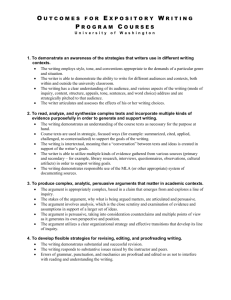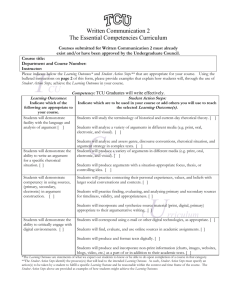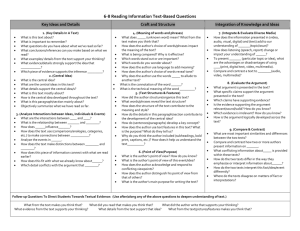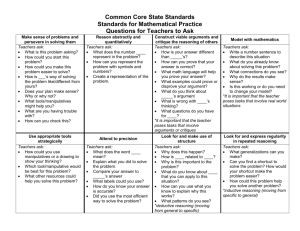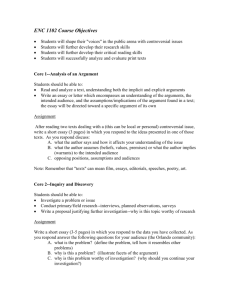Twelfth Grade Writing The Argument: Social Commentary
advertisement
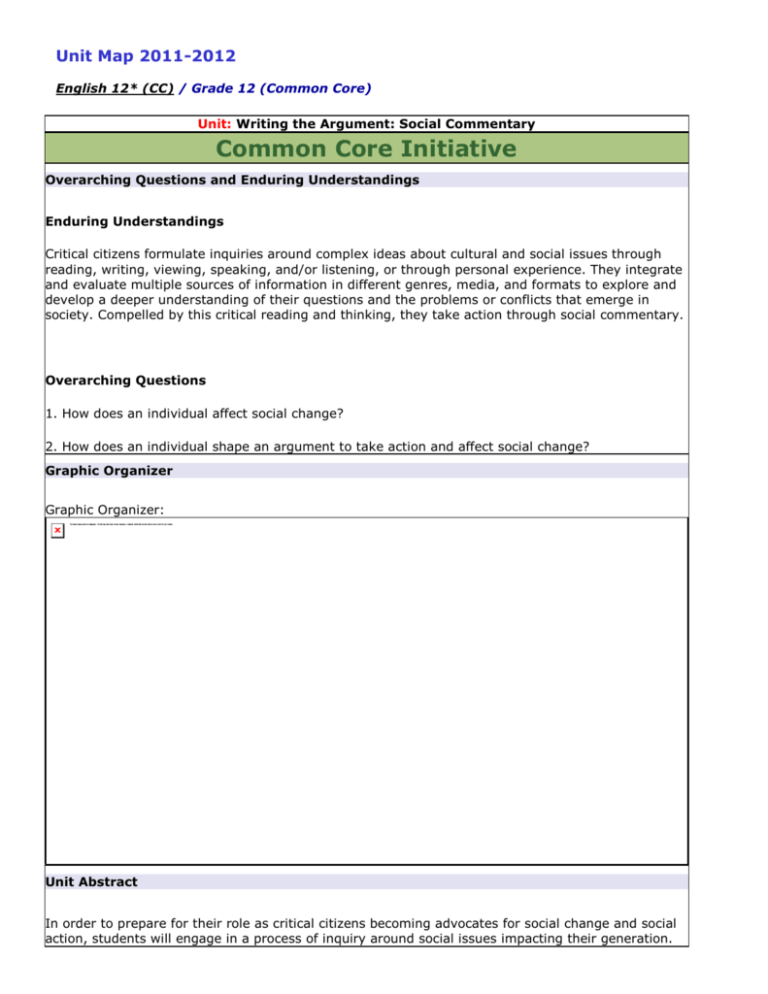
Unit Map 2011-2012 English 12* (CC) / Grade 12 (Common Core) Unit: Writing the Argument: Social Commentary Common Core Initiative Overarching Questions and Enduring Understandings Enduring Understandings Critical citizens formulate inquiries around complex ideas about cultural and social issues through reading, writing, viewing, speaking, and/or listening, or through personal experience. They integrate and evaluate multiple sources of information in different genres, media, and formats to explore and develop a deeper understanding of their questions and the problems or conflicts that emerge in society. Compelled by this critical reading and thinking, they take action through social commentary. Overarching Questions 1. How does an individual affect social change? 2. How does an individual shape an argument to take action and affect social change? Graphic Organizer Graphic Organizer: Unit Abstract In order to prepare for their role as critical citizens becoming advocates for social change and social action, students will engage in a process of inquiry around social issues impacting their generation. Preliminary exploration will build knowledge, raise questions, deepen thinking, and prepare students to develop a stance and form an argument. To do so, students will engage in reading, viewing, primary and secondary research, discussion, blogs or other digital spaces, and/or debates. Students will consider the thoughts of others applying patterns of respectful listening and collaboration as they test their beliefs against the beliefs of others. Through the clarification of ideas, gathering of valid evidence and warrants that support multiple claims, students will design and create an argumentative product intended to promote social action and change. Students will use the writing process to clarify their thinking and product in anticipation of publication for an authentic audience. Content Expectations CCSS: English Language Arts 6-12, CCSS: Grades 11-12, Reading: Informational Text Key Ideas and Details 1. Read closely to determine what the text says explicitly and to make logical inferences from it; cite specific textual evidence when writing or speaking to support conclusions drawn from the text. RI.11-12.1. Cite strong and thorough textual evidence to support analysis of what the text says explicitly as well as inferences drawn from the text, including determining where the text leaves matters uncertain. 3. Analyze how and why individuals, events, and ideas develop and interact over the course of a text. RI.11-12.3. Analyze a complex set of ideas or sequence of events and explain how specific individuals, ideas, or events interact and develop over the course of the text. 5. Analyze the structure of texts, including how specific sentences, paragraphs, and larger portions of the text (e.g., a section, chapter, scene, or stanza) relate to each other and the whole. RI.11-12.5. Analyze and evaluate the effectiveness of the structure an author uses in his or her exposition or argument, including whether the structure makes points clear, convincing, and engaging. Integration of Knowledge and Ideas 7. Integrate and evaluate content presented in diverse formats and media, including visually and quantitatively, as well as in words. RI.11-12.7. Integrate and evaluate multiple sources of information presented in different media or formats (e.g., visually, quantitatively) as well as in words in order to address a question or solve a problem. 8. Delineate and evaluate the argument and specific Unit Level Standards claims in a text, including the validity of the reasoning as well as the relevance and sufficiency of the evidence. (Not applicable to literature) RI.11-12.8. Delineate and evaluate the reasoning in seminal U.S. texts, including the application of constitutional principles and use of legal reasoning (e.g., in U.S. Supreme Court majority opinions and dissents) and the premises, purposes, and arguments in works of public advocacy (e.g., The Federalist, presidential addresses). 9. Analyze how two or more texts address similar themes or topics in order to build knowledge or to compare the approaches the authors take. RI.11-12.9. Analyze seventeenth-, eighteenth-, and nineteenth-century foundational U.S. documents of historical and literary significance (including The Declaration of Independence, the Preamble to the Constitution, the Bill of Rights, and Lincoln’s Second Inaugural Address) for their themes, purposes, and rhetorical features. Range of Reading and Level of Text Complexity 10. Read and comprehend complex literary and informational texts independently and proficiently. RI.11-12.10. By the end of grade 11, read and comprehend literary nonfiction in the grades 11–CCR text complexity band proficiently, with scaffolding as needed at the high end of the range. CCSS: English Language Arts 6-12, CCSS: Grades 11-12, Writing Text Types and Purposes 1. Write arguments to support claims in an analysis of substantive topics or texts, using valid reasoning and relevant and sufficient evidence. W.11-12.1. Write arguments to support claims in an analysis of substantive topics or texts, using valid reasoning and relevant and sufficient evidence. W.11-12.1a. Introduce precise, knowledgeable claim(s), establish the significance of the claim(s), distinguish the claim(s) from alternate or opposing claims, and create an organization that logically sequences claim(s), counterclaims, reasons, and evidence. W.11-12.1b. Develop claim(s) and counterclaims fairly and thoroughly, supplying the most relevant evidence for each while pointing out the strengths and limitations of both in a manner that anticipates the audience’s knowledge level, concerns, values, and possible biases. W.11-12.1c. Use words, phrases, and clauses as well as varied syntax to link the major sections of the text, create cohesion, and clarify the relationships between claim(s) and reasons, between reasons and evidence, and between claim(s) and counterclaims. W.11-12.1d. Establish and maintain a formal style and objective tone while attending to the norms and conventions of the discipline in which they are writing. W.11-12.1e. Provide a concluding statement or section that follows from and supports the argument presented. Production and Distribution of Writing 4. Produce clear and coherent writing in which the development, organization, and style are appropriate to task, purpose, and audience. W.11-12.4. Produce clear and coherent writing in which the development, organization, and style are appropriate to task, purpose, and audience. (Grade-specific expectations for writing types are defined in standards 1–3 above.) 6. Use technology, including the Internet, to produce and publish writing and to interact and collaborate with others. W.11-12.6. Use technology, including the Internet, to produce, publish, and update individual or shared writing products in response to ongoing feedback, including new arguments or information. Research to Build and Present Knowledge 7. Conduct short as well as more sustained research projects based on focused questions, demonstrating understanding of the subject under investigation. W.11-12.7. Conduct short as well as more sustained research projects to answer a question (including a self-generated question) or solve a problem; narrow or broaden the inquiry when appropriate; synthesize multiple sources on the subject, demonstrating understanding of the subject under investigation. 8. Gather relevant information from multiple print and digital sources, assess the credibility and accuracy of each source, and integrate the information while avoiding plagiarism. W.11-12.8. Gather relevant information from multiple authoritative print and digital sources, using advanced searches effectively; assess the strengths and limitations of each source in terms of the task, purpose, and audience; integrate information into the text selectively to maintain the flow of ideas, avoiding plagiarism and overreliance on any one source and following a standard format for citation. Range of Writing 10. Write routinely over extended time frames (time for research, reflection, and revision) and shorter time frames (a single sitting or a day or two) for a range of tasks, purposes, and audiences. W.11-12.10. Write routinely over extended time frames (time for research, reflection, and revision) and shorter time frames (a single sitting or a day or two) for a range of tasks, purposes CCSS: English Language Arts 6-12, CCSS: Grades 11-12, Speaking & Listening Comprehension and Collaboration 1. Prepare for and participate effectively in a range of conversations and collaborations with diverse partners, building on others’ ideas and expressing their own clearly and persuasively. SL.11-12.1b. Work with peers to promote civil, democratic discussions and decisionmaking, set clear goals and deadlines, and establish individual roles as needed. SL.11-12.1c. Propel conversations by posing and responding to questions that probe reasoning and evidence; ensure a hearing for a full range of positions on a topic or issue; clarify, verify, or challenge ideas and conclusions; and promote divergent and creative perspectives. SL.11-12.1d. Respond thoughtfully to diverse perspectives; synthesize comments, claims, and evidence made on all sides of an issue; resolve contradictions when possible; and determine what additional information or research is required to deepen the investigation or complete the task. CCSS: English Language Arts 6-12, CCSS: Grades 11-12, Language Knowledge of Language 3. Apply knowledge of language to understand how language functions in different contexts, to make effective choices for meaning or style, and to comprehend more fully when reading or listening. L.11-12.3. Apply knowledge of language to understand how language functions in different contexts, to make effective choices for meaning or style, and to comprehend more fully when reading or listening. L.11-12.3a. Vary syntax for effect, consulting references (e.g., Tufte’s Artful Sentences) for guidance as needed; apply an understanding of syntax to the study of complex texts when reading. Essential/Focus Questions 1. 2. 3. 4. 5. 6. What social issues do I have an authentic urgency for and am motivated to pursue? What ethical complexities will stretch my beliefs and impact my writing? How will my interaction and response to the thinking and writing of others (including peers) influence my thinking and writing? How can my thinking, speaking, or writing influence others? What modes, formats, and forms of media are currently used for social action and social commentary? How will the modes, formats, and forms of media influence my argument? Assessment Tasks Key Concepts Toulmin Model of Argument audience purpose context multi-modal multi-media Intellectual Processes 1. Formative Assessment Tasks 1. Argument Inquiry: At this point, reread your annotations and identify the current social issue that impacts you and you are most compelled to action upon. Write a 1-2 paragraphs that identifies the critical turns in your investigate that cause you to select this issue and explain why and how you might act to cause social change? Include an annotated bibliography to demonstrate that you have read and thought widely on this issue. 2. First Draft of Argumentative Product: Identify where you have included the key elements of Toulmin's model of argument. Students have a repertoire of cognitive and metacognitive skills and strategies for problem solving, decision making, and inquiry. 2. Through explicit emphasis on intellectual processes, students will become aware of the nature of thinking and their mental capability to control attitudes, dispositions, and development. 3. Through numerous experiential activities, students will be able to use thinking skills and strategies with increasing independence and responsibility. 4. Engage in authentic learning experiences to maximize learning and transfer. Unit Assessment Task What current ideas or events impact you and your generation? After reading informational texts, literature, essays, visual and digital texts on historically important social issues that impacted a generation as well as current social issues that might impact your generation, create an argumentative product that promotes social action and change. Support your argument with evidence from your research and personal experience. Lesson Sequence Reading Immersion: Annotation of multi-genre, multi-media sources Independent collection of artifacts around an inquiry Response formetacognition Response to develop arguments (analyzing and evaluating sources) craft to clarify a line of reasoning Exploration of a Social Issue Multiple claims A range of evidence and warrants experimentation with a line of reasoning Writing the Essay Study the genres, structures, and craft of other arguments focused on social commentary Develop valid argument and product intended for an authentic audience Revise and edit content, organization, style, and conventions Resources Everything's an Argument by Lunsford and Ruszkiewicz They Say, I Say: The Moves That Matter in Academic Writing by Graff and Birkenstein Teaching Argument Writing, Grades 6-12: Supporting Claims with Relevant Evidence and Clear Reasoning by Hillocks, Jr.


